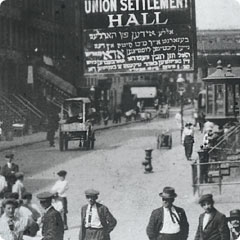| |
||
 Street scene on East 104th Street, c.1900. The sign on the Union Settlement Hall, written in Yiddish with some transliterated Americanisms, reads "All Jews of Harlem: We provide you with seats in this light, airy auditorium. Cantor Rubin will be invited with his famous choir. Tickets can be obtained here from 1PM until 10PM." Union Settlement House was created by Union Theological Seminary alumni. This photograph is from the Union Settlement House Records in Columbia's Rare Book and Manuscript Library. Rare Book and Manuscript Library, Columbia University Courtesy of Union Settlement House |
When Harlem Was Jewish was written by Jeffrey Gurock, Libby M. Klaperman professor of Jewish history at Yeshiva University, as his doctoral dissertation at Columbia University (1977). In this chapter, "Decline of Jewish Harlem, 1920–1930," Professor Gurock traces the exodus of Jews from Harlem in favor of Harlem's growing African American population. |